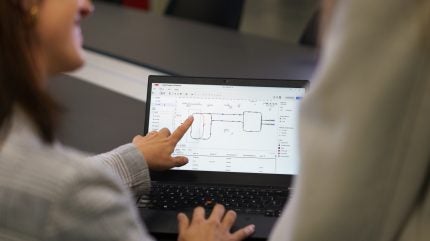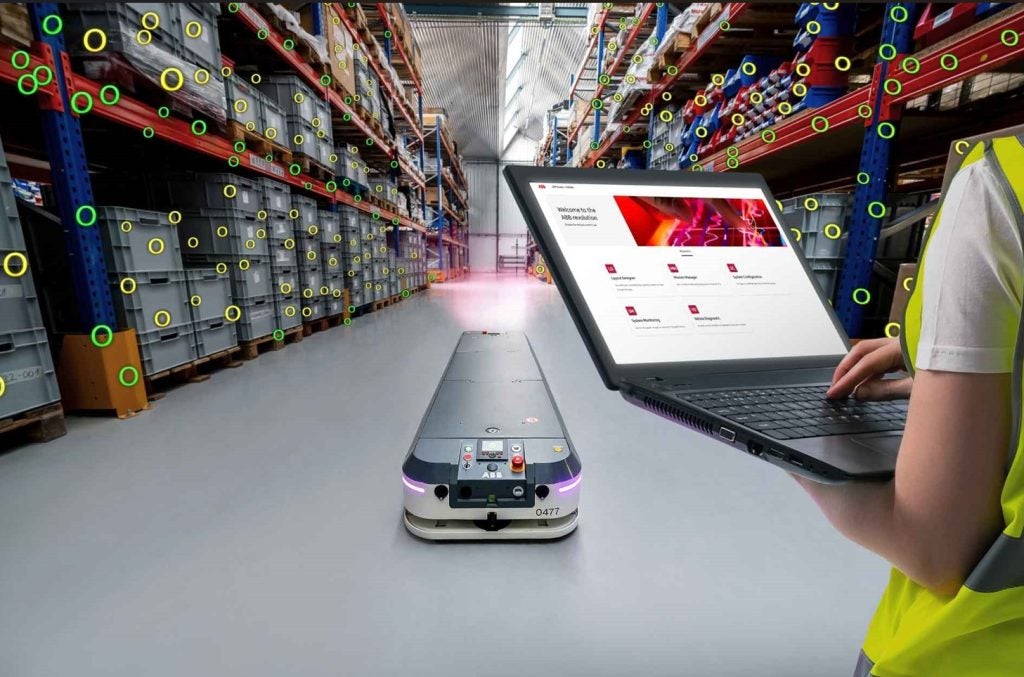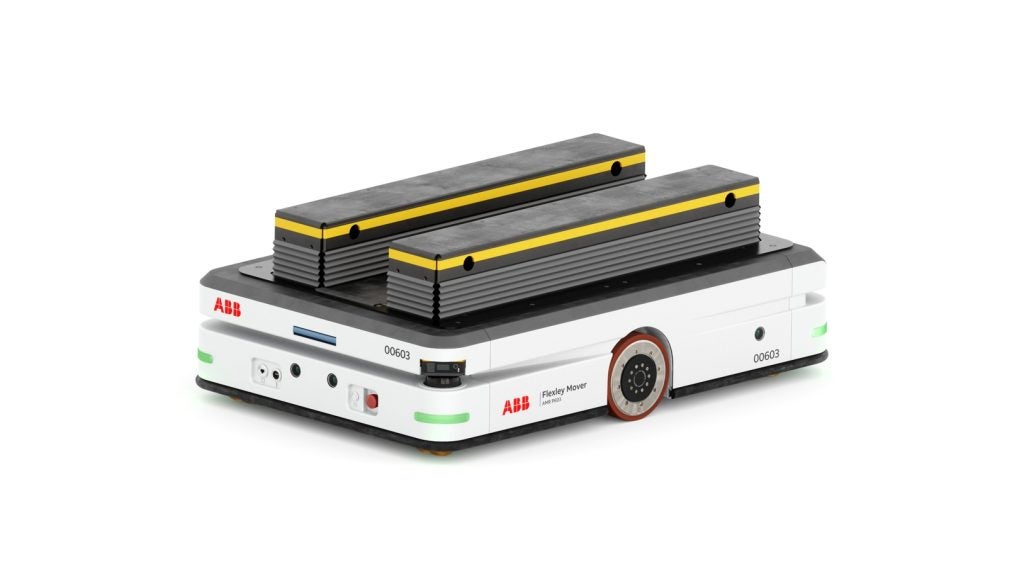
ABB Robotics is a leading supplier of industrial and collaborative robots, as well as machine automation solutions. The robotics division of ABB serves a wide scope of sectors including the automotive industry, where autonomous mobile robots (AMRs) are used to assist with tasks such as welding, painting, material handling and vehicle assembly.
The three primary AMRs used within the automotive space are the Flexley Tug, Flexley Mover and Flexley Stack which are each able to carry out different tasks such as pulling trolleys, handling pallets and containers, and transporting heavy loads of up to 1,500kg.
Alongside this, the AMRs can be integrated at various points along the vehicle manufacturing line, from assembly and subassembly, line operations and kitting all the way through to transport of products.
The use of robots within an automotive production line brings with it benefits including 24/7 operation due to the robots not needing breaks in work or holiday, enabling round the clock production. Another benefit these robots bring is down to their size; AMRs have a compact footprint and can work in confined or high-reach spaces, which saves floor space in an automotive facility.
The environment is also something which ABB has kept in mind; the accuracy and precision of robotic automation cuts down on material waste. Alongside this, ABB offers services that extend robot lifetimes through data-driven maintenance, providing remanufacturing and buy-back programs, with 60% to 80% of components being reused.
On a recent trip to ABB facilities located in Madrid, and also the factory in Burgos, Spain, Frankie Youd heard from Alfonso Gonzalez, global head of mobile robotics, ABB, Pedro Garrido, global sales manager, ABB, and Joerg Reger, managing director, global business line robotics to learn more about the way the AMRs operate and what the future holds for robotics in the automotive space.
Just Auto (JA): Could you discuss the different autonomous mobile robots (AMRs) that are available?
Alfonso Gonzalez (AG): We have three main types at this facility. Firstly, we have the Flexley Tug. They use a pin hook to pull a trolley, and on top of the trolley you can put whatever you want, because the trolleys are generally tailor-made for the customer application. The towing capacity depends on the model, the T701 and T702 can handle a payload of up to 2,000 kg, and the T901 is designed for heavy loads up to 10 tonnes. You can use the trolley to move the body of a car – this is very typical in the automotive industry.
Next is the Flexley Mover, the concept is of the vehicle is similar, but the use case is quite different. With the Flexley Mover, you put the loads on top of the AMR; it can transport loads on top such as containers which weigh 600kg to 1,500kg. These are also used heavily in the automotive industry.
For these two AMRs you need stations; these are the places where the AMR goes and picks up the trolley or the load. These can be programmed for the AMR.
Then there is the Flexley Stack. These AMRs can pick loads at different heights and they are similar to a forklift. They have a counterbalance in them. This means that they can go into a warehouse, they can go to – say – the third floor of the warehouse and pick up a load, and get it to a different place.

Could you discuss the software platform which enables OEMs to programme the AMRs?
AG: We have a software called ‘AMR Studio’. AMR studio is software, which is easy to use. You don’t need to be a specialist in programming, or need to understand coding in order to use it.
It includes what we call Layout Designer. If you want a certain number of AMRs to move inside a factory, you have to manage a layout; you can modify and design the paths of the AMRs which are automatically updated on the map.
Then you have a Traffic Manager and diagnostic tools, if something happens to the AMR, you can take the information and see what has been flagged up. Fleet Manager takes charge of the full fleet. It manages the flows, the traffic and the prioritisation of tasks. It is assigning certain tasks to a certain AMR, based on the battery, ongoing operations and the next task to be executed.
How are the different AMRs able to navigate?
AG: Navigation is what helps the AMR move inside a factory. The first type of navigation that was developed is magnetic navigation. Magnetic navigation means that you put a magnetic tape in the floor, it can be below the floor, and the AMR follows the magnetic tape.
This is for very simple applications, the downside is when you want to change the route it means that you have to change the floor, or the or the magnetic taping in the floor. It is quite easy to commission, but quite unflexible.
Laser navigation is the second type of navigation. It uses reference points and is receiving information via triangulation. It is also called VSLAM (visual simultaneous location and mapping); it enables the AMRs to ‘see’ the real world in real-time. By using AI the AMRs can notice the difference between fixed references (floor, ceilings and walls), and objects that change position such as people. They are able to do this by using the cameras which they are fitted with, allowing them to have 3D mapping capabilities.
They are seeing the environment, they are understanding the environment, and they are localising themselves inside that environment. Here we don’t need additional infrastructure on the floor; the AMRs with the cameras are able to understand where they are – they are building a map. They are even sending the map to the server, and this is increasing the precision and the accuracy of multiple AMRs inside the layout, because all of them are giving inputs.
However, laser and VSLAM navigation have a drawback, and it is that you need an infrastructure around the AMRs to make sure that they receive the feedback of what the laser is sending.
Lastly, we have QR code navigation. This is very typical for logistic applications and where you have an automated warehouse. You can put a lot of QR codes in the floor, and the AMRs move by QR which each have a direction or instruction on them.

Is the want/need for automated robotics growing?
Pedro Garrido (PG): The AMR market has been growing between 20% and 25% over the last 5-10, years. When I started working in robotics 80% to 90% of the robots that we were installing were in automotive. They then moved to other areas like welding, general industry, logistics, packaging.
The mass utilisation of AMRs comes from the goods to persons industry, and the warehouses. I personally believe that the use of AMRs in automotive will increase more and more.
This is also linked to industry trends. We have a lot of regulations in Europe, a lot of regulations in North America, not so many safety regulations in China.
What we are seeing right now in the industry is that many Chinese manufacturers that were busy with the domestic market are moving to Europe, and they are moving to us, and one of the things that they need to do is undergo a huge amount of work to get up to speed with safety certifications, because those were not mandatory in China.
What will the future of automation look like?
Joerg Reger (JR): When looking at the future there are two important pillars. One is that mobile robotics will be everywhere. Mobile robotic means where you have people transporting things from the warehouse to the line, this will be automated by AMRs.
The second pillar is modular cell concepts; we see the inbound and outbound being automated by mobile employees. The warehouse needs to be automated completely, and in front of the warehouse, we will have a kitting zone where we are taking things directly from the warehouse with the robots and putting the parts together that you need for one type of main part.
The automated kitting zone brings a lot of flexibility. You can have a tracking system which you can say: “We want to produce product number A”, the AMR puts everything in the kitting zone on the trolley. It can be super flexible in how many types of product you can produce in one production unit.
Instead of having a separate line for each type, we are now able (due to the AMRs) to have five, six different types in one production unit. In automotive, we have now the hybrids, we have the pure electrics, we have the traditional combustion engines – this will enable them to manufacture these all-in-one production line rather than separate lines.
One OEM that we work with is using this mixed production line system. They are producing different types of modules that they have in one line, they have not split it like other OEMs generally do.
In future, people are starting to talk about extremely highly automated dark production factories. I have seen them in China. They are really dark. You step in, they turn the light on, and then you see the automation running, no humans.
If the Western world is to survive, the only way to do it is to bring in more automation. With this flexible automation, it is a step in the right direction, and to lower our costs in production which is a key topic for the Western world.
Do you see a place for the use of humanoid robots within automated processes?
JR: I think it’s really a philosophy issue here. If you talk to Tesla, they really want to launch them as soon as possible in their factories. When I have spoken to other automotive OEMs, they are saying they also want humanoid robots.
However, they also say they have problems with labour unions. If you have a humanoid robot which really looks like a human, this is an issue for them. There is also a concern around safety. Sometimes these robots fall over, and they weigh around 80 kilograms, so they are actually heavy machines falling down.
The coordination is hard to get right. You have to get the arms and legs just right. They have a lot of technology issues or challenges before this is really solved.








